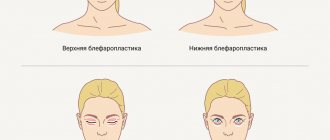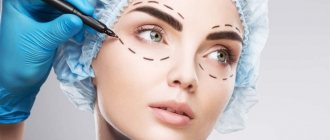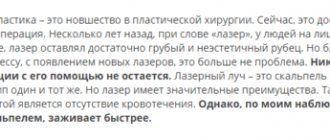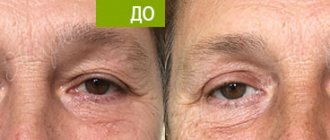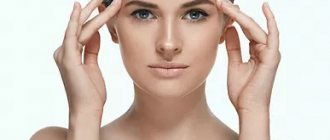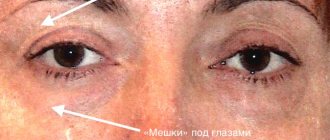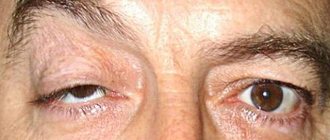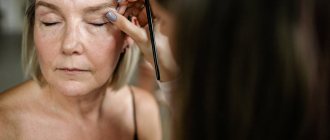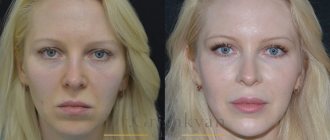- home
- Lipofilling
- Lipofilling of the upper and lower eyelids in Moscow
Lipofilling of the upper and lower eyelids can be widely used as an independent operation. Lipofilling of the eyelids will correct
- A-shaped deformation of the upper eyelids
- failed blepharoplasty
- tear trough
- bruises under the eyes
- lower eyelid hernia
With age, the layer of adipose tissue in the eyelid area becomes noticeably thinner, and the fat itself migrates and becomes deformed. Achieving the desired result in the shortest possible time, with a minimum rehabilitation period and with low risks and complications is the task that the patient sets for us. This may be why lipofilling of the face and, in particular, the eyelids is becoming increasingly popular. After all, lipofilling can meet all these requirements.
View all photos before and after eyelid lipofilling
Myths about lipofilling
1. All this fat is absorbed This is not true. Indeed, some part of the displaced fat undergoes resorption, that is, it is absorbed by the body. But a significant proportion of fat (70-80%) takes root in a new place and continues to live its own life, maintaining its properties characteristic of the fat of the area of the body from which it was taken by the surgeon. What does fat engraftment depend on? From the ratio of the amount of transferred fat and the amount of adipose tissue in the area of the body whose volume we want to increase. That is, there is no need to be greedy and transplant too much - the excess fat will really resolve. I compare this to the arrival of guests - if ten people come to a small apartment, this is impossible. If a couple of guests come to a big house, it’s a joy.
2. After lipofilling, there may be lumps of tissue and uneven surface of the skin. This is not true. There are a number of technical features of the operation that make it possible to completely eliminate such problems. We use lipofilling to increase the volume of tissue to correct the shape of the breast, eliminate age-related changes in the hands and face, and correct the shape of the legs and buttocks.
The author's method of eyelid rejuvenation by Professor D.R. Grishkyan
World expert in the field of lipofilling, professor, doctor of medical sciences David Rubenovich Grishkyan says:
... The widespread use of eyelid lipofling as a method of rejuvenating the periorbital region is hampered by the imperfection of the technology for introducing a fatty autograft. It is known that the relative, at first glance, simplicity of the technique can play a “wicked joke” on the surgeon, leading to complications. But the complication of lipofilling can only be corrected surgically. Work on the eyelid lipofilling method in order to obtain an “ideal” result is still ongoing. Such a feature as the unpredictability of the engraftment of fat autograft is not so significant today. But we pay special attention to the issue of the volume of one-time injection of fat. Why do I consider this question to be the main one in obtaining the desired result in rejuvenating the lower eyelids? Let me explain the main points:
Correction of A-deformation of the upper eyelid.
• Techniques for fat injection during eyelid lipofilling
As a rule, when carrying out lipofilling, two main techniques are used. The first is the so-called “spraying” method. With this method, a small amount of fat is injected into a specific area using dozens of small strokes.
Blepharoplasty of the upper eyelids and lipofilling of the midface, including the lower eyelids.
The second technique is the linear insertion technique. In our opinion, the first technique has a number of disadvantages. – Numerous movements of the cannula cause tissue injury. – Tissue swelling may interfere with the analysis of the results obtained. – It is difficult to control the volume of injection, especially if the surgeon does not have sufficient experience in performing the operation. – As a rule, the introduction of fat with this technique occurs when the cannula moves forward, which is fraught with complications. In his daily practice, surgeon D.R. Grishkyan uses the technique of slow retrograde linear injection of fat autograft.
In the lower eyelids, fat is added for correction even in the presence of hernias. The volume of fat in hernias is not sufficient to correct all the voids in the infraorbital region. Therefore, promises of fat redistribution to smooth the lower eyelid area do not work.
This technique allows you to carefully control the volume, layers and area of fat injection, avoiding overcorrection and vascular injury.
• Multi-layering as a principle for introducing fat
The next point is the principle of introducing fat. An important factor is layering. We do not inject fat like a regular filler, but place the graft layer by layer according to the principle of building a pyramid. In this case, it is important from which layer to start adding fat. As a rule, we begin the introduction from the deep layers and then move higher to the skin. However, in some cases it is recommended to start the introduction from the superficial layers. The main choice of layer is the thickness of the leather.
In this case, fat was injected at different depths, into different layers, to correct all the problems of the lower eyelids and midface that arose due to loss of volume.
Result after lipofilling surgery.
• Volume of administration
To correct the periorbital area, we introduce the volume of fat implant that we consider necessary. But the main thing that needs to be taken into account when mentioning the volume of injected fat is the size of the fat autograft . In our practice, we use fat implants of the smallest possible size, and it was the reduction in the size of the injected fat tissue and the combination of techniques that allowed us to increase the volume of injection, avoiding complications
Breast lipofilling
The statistics of breast augmentation using lipofilling number thousands of cases. Breast lipofilling has become an independent method.
It has a number of advantages over using implants:
♦ There are no problems associated with the placement of a foreign body into the body (rejection, capsular contracture, etc.). The implant can be felt, and its folds under certain conditions can be visible through the skin. This is not typical for natural fat that has taken root ♦ There are no incisions, no postoperative scars on the skin ♦ There is no problem of displacement or rotation of the implant ♦ In addition to an increase in breast volume, the patient receives a decrease in volume in the places where the fat is taken from
Of course, to noticeably enlarge your breasts, you need a fairly large amount of fat - 300-400 ml. The patient does not always have sufficient fat deposits for this. Moreover, as a rule, breast augmentation is performed on thin women who have difficulty finding excess fat for grafting. But, at the same time, there is a muscular body type, which is also called “heavy bottom - light top”: thin shoulders and torso, small breasts, but voluminous stomach, buttocks and thighs. For such patients, breast lipofilling is an ideal option, especially in cases where they do not want a strong increase in volume, but want a natural result with a minimum of scars. The operation is performed under anesthesia. The duration of the postoperative period is about two weeks, swelling and slight pain can persist for up to a month. But severe pain, such as, for example, after a significant breast augmentation with silicone implants placed under the pectoralis major muscle, does not occur after lipofilling. You will need to wear compression garments for a month after surgery.
In addition to breast augmentation with fat alone, lipofilling is an excellent method for improving the results of breast augmentation with implants. Using fat transfer, we increase the thickness of the covering tissue in those places where the implant can be felt or visible.
Lipofilling of the lower eyelids
As for lipofilling of the lower eyelids, it is relevant both for pronounced tear troughs and in the presence of fatty protrusions (hernias). Pronounced tear trough is an extremely common problem. Moreover, it is observed not only in middle-aged patients who require full-fledged blepharoplasty, but also at a fairly young age.
The main reasons for the formation of unaesthetic depressions in the lower eyelids:
- With an anatomical tendency to a pronounced tear trough or features of the anatomical structure of the face with a lack of adipose tissue in the lower eyelids
- Consequences of traditional lower eyelid blepharoplasty with radical removal of fatty hernias
- Sudden weight loss, causing the development of skeletonization of this area of the face
What problems in the lower eyelid area can lipofilling help with?
Tear trough
Modern aesthetic surgery allows you to correct the tear trough, but when determining correction methods, a clear diagnosis of the causes of its formation is necessary. The most common reason is lack of volume. Consequently, lipofilling of the lower eyelids gives excellent aesthetic results in this case. Fat allows you not only to even out the area under the eyes, but also has a significant rejuvenating effect on the delicate skin of the eyelids. If the patient has excess skin, then lower eyelid plastic surgery is also indicated simultaneously with lipofilling.
In this case, lipofilling of the tear trough with correction of the zygomatic region was performed on a very young patient, 24 years old. The result continues to this day, for more than 8 years. Including after childbirth and breastfeeding.
Bags under the eyes
Another problem for patients seeking lower eyelid surgery is bags under the eyes. Often these patients do not realize that the problem exists at the tear trough level. The logic behind standard blepharoplasty is the decision to remove hernias in the lower eyelids down to the level of the tear trough. As a result, the patient receives either dark circles under the eyes, or, worse, drooping of the lower eyelids and an unaesthetic depression under the eyes.
In our opinion, the approach should be exactly the opposite. Adding volume during lipofilling of the lower eyelid to the area under the eyes allows not only to camouflage hernias. By equalizing differences in the levels of the hernia and the tear trough cavity, it is possible to achieve even, beautiful volumetric rejuvenation of the lower eyelid and skin. After all, the fat that we use for lipofilling contains a large number of growth factors that contribute to the rejuvenation of the eyelid skin.
Dark circles under the eyes
Another problem that lipofilling of the lower eyelids can cope with is dark circles under the eyes. A common cause of darkening of the skin around the eyes is the presence of closely spaced blood vessels and at the same time thin skin of the lower eyelids. In addition, dark circles are often the result of a pronounced tear trough, or skeletonization of the lower eyelid as a whole. In this case, lipofilling of the lower eyelid becomes the only option for solving the problem.
Lipofilling of the buttocks
In buttock enlargement, lipofilling played almost a greater role than in breast enlargement. The fact is that the buttock implant leads to gradual atrophy of the muscle located above it and becomes visible. In addition, the volume of the buttocks decreases again due to a decrease in the volume of the muscle, which has atrophied under the pressure of the implant. Lipofilling, which allows you to increase the layer of subcutaneous fat above the implant and hide it, opens up the possibility of installing the implant under the fascia, which does not lead to thinning of the muscle and reduces postoperative pain.
What is facial lipofilling
According to the overwhelming majority of experts, lipofilling is the optimal and safest way to correct emerging and congenital changes in the shape of the face.
The patient's adipose tissue used for lipofilling is not rejected by the body, and the procedure virtually eliminates the occurrence of allergic reactions. After the operation, no noticeable marks remain, the skin has a fresh, voluminous appearance, and wrinkles are smoothed out. This intervention is often performed in combination with other plastic surgeries.
Prices
| PLASTIC SURGERY | PRICE, |
| Lipofilling of hands under local anesthesia | 110 000 |
| Lipofilling of hands under anesthesia | 130 000 |
| Lipofilling of the upper eyelids | 70 000 |
| Lipofling lower eyelids | 70 000 |
| Lipofilling of the upper and lower eyelids | 100 000 |
| Facial lipofilling | 150 000 |
| Lipofilling of the legs | 150 000 |
| Lipofilling of nasolabial folds | 50 000 |
| Lipofilling of cheekbones | 90 000 |
| Cheek lipofilling | 90 000 |
| Lipofilling of the buttocks | 390 000 |
| Elbow lipofilling | 90 000 |
| Breast lipofilling | 290 000 |
| Lipofilling of the labia majora | 50 000 |
| Corrective lipofilling of the body 1 zone | 90 000 |
Rehabilitation during eyelid lipofilling
Lipofilling of the eyelids, like any other lipofilling, is a low-traumatic procedure. It can be performed under local anesthesia, and the patient leaves the clinic on the day of the operation. After lipofilling of the eyelids, as a rule, there are no bruises or scars left on the face, and swelling is minor and goes away on its own within two weeks. The main injury occurs in the area of the donor zones; bruising and swelling may remain there. This is especially possible if the patient simultaneously underwent full liposuction or more extensive lipofilling than just lipofilling of the eyelids. In this case, compression garments and physiotherapeutic procedures are recommended. To prevent the survival of fat and accelerate vascularization, it is recommended to perform several procedures of placental therapy.
In what cases is the procedure contraindicated?
The lipofilling operation has virtually no contraindications. An exception may be serious pathologies, which include:
- low blood clotting rate;
- chronic diseases of internal organs;
- established diabetes mellitus and existing other endocrine disorders;
- existing malignant neoplasms of any location;
- history of heart and vascular disease;
- identified infectious diseases of various origins.
The essence of the procedure
A general medical examination is a must before lipofilling. The surgeon also makes recommendations on the rehabilitation period after the operation.
After the operation, the patient rests for several hours. The result of this intervention will be lifelong, and the time of lipofilling is only about 1 hour. An additional advantage of this type of intervention is the absence of the need for a long hospital stay - you can return home after a few hours after the operation.
Swelling and small bruises in the intervention area disappear within a few days, leaving behind a feeling of youth and beauty for a long time.
The advent of high technologies is also associated with the introduction of the latest medical equipment and devices using laser and radiofrequency effects , which are currently widely used in many areas of plastic and aesthetic surgery. Radiofrequency and laser exposure promote the fastest healing of wounds with minimal and almost imperceptible scars, since in the least traumatic manner . Due to their versatility and multifunctionality, these devices are used in a variety of plastic surgeries. Laser technology has found its greatest application in lipomodeling procedures (including thighs), since as a result it is necessary to achieve not only the removal of excess fat, but also to achieve an even and smooth surface of the figure. Among the advantages of performing operations using radiofrequency and laser liposuction (chin, thighs, buttocks and other areas of the body), less pain and a shorter postoperative rehabilitation period can be identified.
Stages of the procedure
The operation is performed under general anesthesia and takes about 1.5 hours. First, fat tissue is obtained from the patient's thighs or abdomen. To do this, they use the finest instruments that allow the collection of biomaterial without disturbing its structure. Then, small incisions are made in the areas targeted for correction, through which fat is implanted. For best results, the procedure can be repeated after a few months. In young patients, almost complete graft survival is observed. Older patients can undergo up to 3 lipofilling procedures.
In what cases is lipofilling prescribed?
This procedure is designed to eliminate a number of emerging problems:
- age-related changes in individual features and facial contour;
- significant loss of volume in certain areas;
- sagging skin, pronounced jowls, deep folds near the nose;
- atrophic scars;
- noticeable asymmetry of any origin.
Fat grafting is successfully used as an alternative to operations involving the installation of facial implants. The technique is designed to significantly rejuvenate the face, effectively increase skin tone, elasticity and firmness.
Effectiveness of the procedure
Since lipofilling is the least traumatic procedure, it is often recommended to quickly restore youth to the face and give a more attractive appearance to both the face and body. Getting rid of pronounced nasolabial folds, tear troughs, eliminating defects in the lower part of the face due to insufficient fat tissue in this area - all this quickly returns youth and gives self-confidence.
And since this particular procedure is not based on the introduction of a temporary “beauty injection”, which has a pronounced effect only for a limited time, but on the use of one’s own adipose tissue, the duration of the manifestation is guaranteed to be long.

